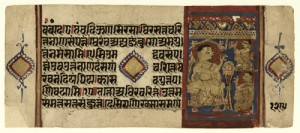The Special Collections Research Center unveiled a new exhibit this week that traces the relationship between University of Chicago scholars and the texts and manuscripts of the Indian subcontinent.
Envisioning South Asia: Texts, Scholarship, and Legacy marks the 50th anniversary of the founding of the Department of South Asian Languages and Civilizations (SALC) and the 60th anniversary of the founding of the Committee on Southern Asian Studies (COSAS). Ulrike Stark, Ph.D, of the SALC department, Anna Seastrand, Ph.D., of the Department of Art History, and Ian Desai, Ph.D., of the Society of Fellows in the Liberal Arts co-curated the exhibition.
Envisioning South Asia includes artifacts that reflect both the rich manuscript culture indigenous to India and the effect that colonial powers had on shaping such scriptural and literary traditions in the modern era. The exhibit is loosely divided into sections of sacred manuscripts, European-drawn maps, volumes published by Christian missionaries, administrative documents from the British colonial era, and modern pamphlets, novels, and assorted periodicals.
The exhibit also highlights the history of scholarship of South Asia at the University through the papers and personal effects of Milton Singer, Edward Dimock, and A.K. Ramanujan, scholars of Indian culture and languages who were instrumental in the development of South Asian studies at the University. Combing through the history of these “Chicago Pioneers,” Desai said. “I knew this was going to be a unique experience, and that’s very befitting (the University of) Chicago and its relationship with South Asia, which is absolutely unique and stellar…it is a testament to the extraordinary capacity of the scholars here over the years.”
Desai continued, “This whole experience has been for me a wonderful, eye-opening affirmation of how outstanding our resources are…since the very beginning of this university and straight through the decades, with this burgeoning moment in the ’50s and ’60s that we talk about in the exhibit.”
Highlights of the collection include two 18th-century codices copied on bound palm leaves in the pothi style, and a large Pabuji Ki Phad, a banner painted with images of Pabuji, a Rajasthani folk hero, and traditionally unfurled during ritual performances.
Catechisms and Bibles, translated into the Indian vernacular languages and published by British missionaries in the early 19th century, are also displayed. Maps of the subcontinent drawn by European cartographers, including James Rennell’s 1794 “New Map of Hindoostan”—often regarded as the first near-accurate map of India—further illustrate the impact of colonialism on South Asian documentary culture.
A placard in the exhibit notes that in South Asia, 29 languages are spoken by at least one million people, and the cultural and linguistic variety of the exhibition reflects that diversity. Envisioning South Asia encompasses texts and documents from numerous linguistic traditions: Hindi, Telugu, Bengali, Assamese, Urdu, Gujarati, Sanskrit, and Marathi, among others.
Envisioning South Asia will be in the Special Collections Research Center, located on the first floor of Regenstein Library, until March 18.









